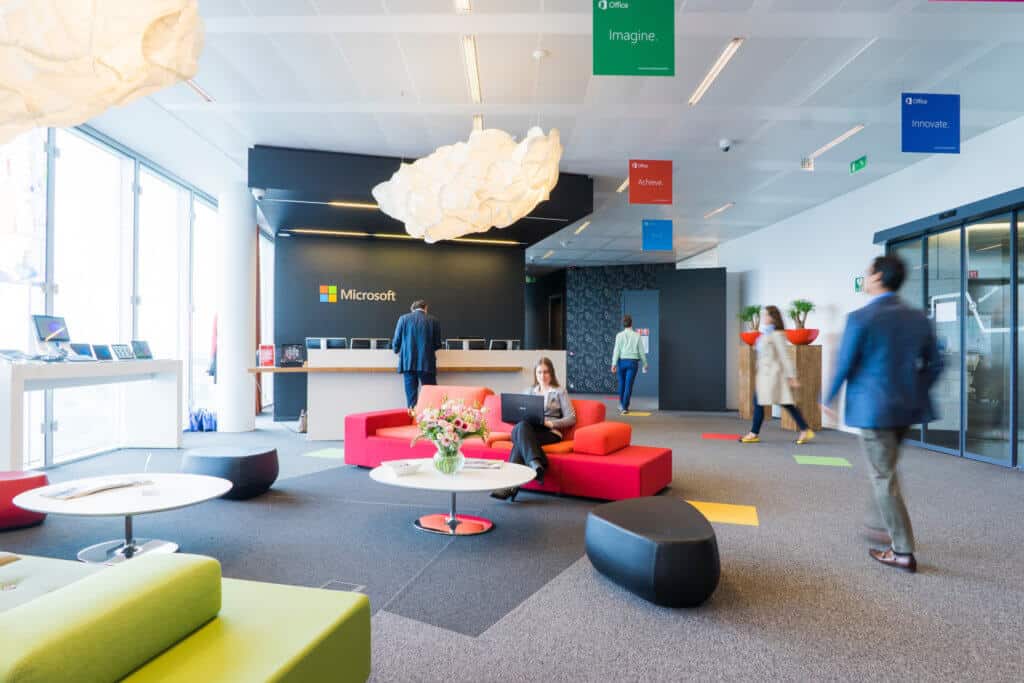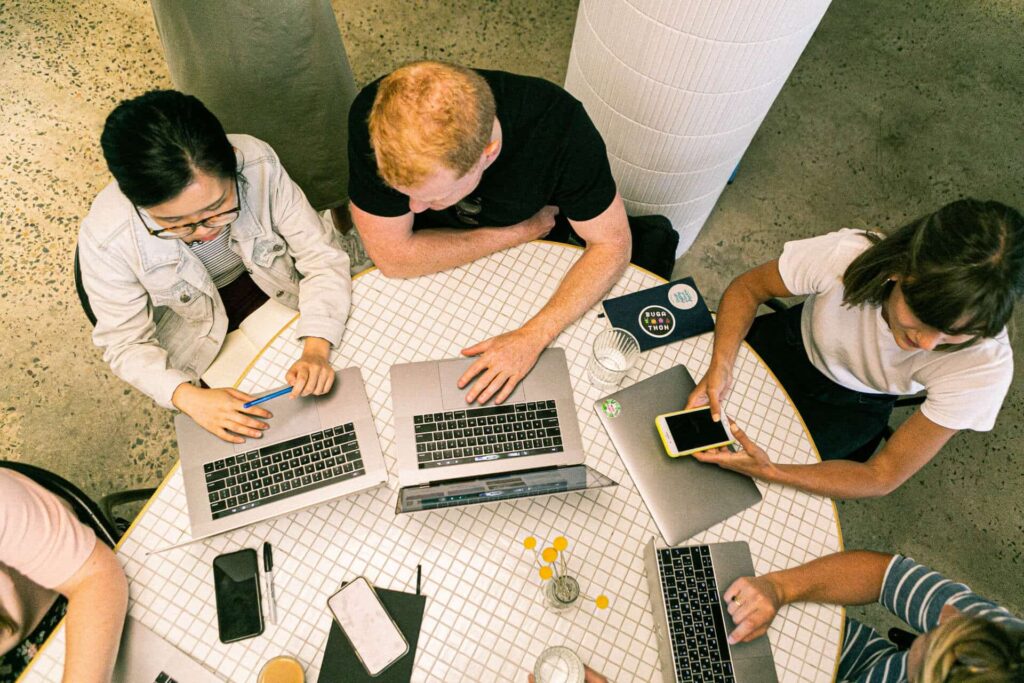Office neighborhood examples: How to manage neighborhoods in the workplace

Office neighborhood examples can give you the information you need to manage neighborhoods in your own workspace through the use of office neighborhood software.
Meeting the demands of hybrid work and agile working head on, office neighborhood software can make the transition to flexible work much easier for employees. But with endless options for customizing office neighborhoods in your workspace and on your floor plan, it can be hard to know where to start.
In this guide, we’ll outline the types of neighborhoods at your disposal. We’ll also show you how other companies are leveraging neighborhood and neighborhood software in their work environments. Finally, we’ll give you some tips for managing office neighborhoods effectively in the workplace.

Types of office neighborhood layouts and when to use them
Although there’s no one-size-fits-all strategy for creating an office neighborhood workspace, starting with a base template or neighborhood “type” can help you determine the best way to create neighborhoods for each of your teams.
Some of the most common types of office neighborhoods include:
- Team-specific neighborhoods
- Activity based neighborhoods
- Open seating neighborhoods
Here’s a deeper explanation of each of these neighborhood types, how they related to specific work settings and work styles, and some tips on when to use them in the workplace.
Team-specific office neighborhood examples
Groups of seating that only a specific team can use are known as team-specific neighborhoods (e.g. the “Marketing Team Neighborhood” and a “Sales Team Neighborhood” could be added to your floor plan).
Team-specific neighborhoods are a great solution when:
- You want to create a better employee experience by giving each team a customized setup
- One (or some) of your teams have specific seating needs (e.g. a Design team needs a neighborhood of larger desks with fixed monitors)
- Your teams can’t make do with one-size-fits-all seating setups
Activity-based office neighborhood examples
Activity-based neighborhoods help you create clusters of desks on your floor plan that support a particular activity or if you have a team that needs a specific setup to do their work. It’s essential that employee needs are met as related to office layout, open space, meeting spaces, hot desking, and more. For example, a “Design Neighborhood” could support a design team workspace that needs access to sewing machines and cutting tables.
Activity-based neighborhoods are a great solution for your working environments when:
- A team has specific workstation requirement (e.g. a Design team needs a group of desks with sewing machines)
- Employees need available spaces in the office for different types of work (e.g. quiet working, group work)
Open seating office neighborhood examples
Anyone can sit down and use a seat in open neighborhoods—no booking required. You can make open neighborhoods available to everyone in the workplace, or set accessibility restrictions so that each open neighborhood is exclusively available to a select group of employees (e.g. the HR team; employees visiting from another building).
Open seating neighborhoods are a great solution when:
- You want to give employees more flexibility in where they can sit and work while they’re at the office.
- Employees need to come into the office for a meeting, huddle, or brainstorming session, and they’d rather book a group-work area or a sofa instead of a regular desk.
- Employees need desks for group work that don’t need to be booked in advance
- You want to provide non-bookable desks or sofas with equipment like whiteboards that employees can work from to break up the workday
- You need open office plans with seating to accommodate visitors or traveling employees who are usually based at another building or location
Because open seating neighborhoods use non-bookable seating, you can use Distancing Planner to make sure all seating is appropriately distanced. And tools like workplace sensors and badge integration can help you track usage until COVID-19 guidelines are relaxed in your region.

Office neighborhood examples from leading brands
Here are some examples of office neighborhoods being used in leading companies:
- Google: Google used urban physics when planning its Chicago workspace, which resulted in designing a room that mimics that of a speakeasy. This space promotes creativity and connection for Google employees.
- Groupon: Like Google, Groupon created a conference room that defies the traditional meeting room space. A tiki-inspired conference room offers an “escape” for employees while fostering fresh ideas.
- Uber: The tech giant took a different approach when planning their headquarters. Uber decided to adopt smaller neighborhood areas that each have access to collaborative, shared support and community spaces.
Office neighborhoods are fully customizable, whether for a large corporation or small business. So if tiki huts and speakeasy-inspired rooms sound a little outside your company culture, don’t stress. You can build whatever space that provides your employees with a sense of belonging and positive workplace experience.
You can set up tailored seating configurations that embody what works best for your company, your real estate portfolio, and your employees. This is far more efficient than running with whatever’s trendy in the world of workplace management right now.

How to manage office neighborhoods in the workplace
Without the right workplace management technology on hand, it won’t be easy for your workplace design teams and employees to deal with neighborhoods in the workplace. In other words: trying to manage office neighborhoods with an Excel spreadsheet is a terrible idea. Office neighborhood software is essential.
Here’s an overview of the flexible working office neighborhood software you’ll need to manage, monitor, and optimize neighborhoods and leverage the benefits of office neighborhoods in your organization.
Desk booking
With desk booking software, you can create a neighborhood with any combination of flexible seat—hot desk, hoteling, by request, assigned-bookable, free addressing—to give every team the exact setup they need whether they need a quiet or collaborative workspace.
For example, let’s say you’re organizing seating for your marketing and design team. Some of the team members need specific tech setups at their desks. Others want to be in the office full-time. And the rest are hybrid workers who split their week between the office and home.
To support this team, you could create a neighborhood with:
- Assigned seating: employees who need a specific desk setup when they’re at the office get a dedicated, assigned seat.
- Bookable seating: 10 hybrid workers could share 5 hot desks.
- Open seating: provide a pod of open seats for last minute drop-ins.
Touchless check in
With employees checking into desk bookings each time they use the office, you’ll always know who’s using every desk.
And because employees can book neighborhood desks in advance, they won’t arrive at the office only to find that they don’t have a seat for the day.
Team-managed seating
With OfficeSpace, you can turn any neighborhood into a team-managed neighborhood. Meaning: a designated seating captain is in charge of managing occupancy, seat assignments, moves, and booking requests.
By putting a team in charge of managing their own seating needs, they’re better placed to decide who should sit where. This can also impact the sense of community in the team.
Facilities can step in to support a team-managed neighborhood whenever a seating captain needs help. But they aren’t burdened with the task of overseeing every booking request or seating change. Bottom line, this a huge win for workplace teams that are going to be stretched to their limit during the return to work.
Team-managed seating is exclusive to OfficeSpace. Book a demo to see this feature in action.
Desk permissions
To manage flexible work efficiently (i.e. plenty of freedom for employees with zero day-to-day upkeep for facilities teams), companies need more control over who can use each desk.
Desk permissions in OfficeSpace allow you to restrict desk usage based on a variety of filters. Including team, department, job title, and more.
These advanced permissions benefit workplace teams and individual employees:
- Facilities has full control over who can use each seat inside each neighborhood
- Workplace teams can control when/how every desk can be used
- Management will always know who’s using (or who’s used) which seat
- It’s easy for every employee to see which desks they can and cannot book on your floor plan
Automated permissions
If managing desk permissions sounds daunting to you, that’s probably because you’re familiar with the old-school method of managing desk permissions.
In the past, permissions had to be set manually for every single desk. So any time employees joined the company, exited the company, or simply switched teams, your already-busy facilities team had to go in and update the desk permissions for those employees.
We solved that problem in OfficeSpace by linking desk permissions to your employee record system. Now, whenever an employee’s record changes, all of the desks that employee can use are updated on your floor plan automatically.
Here are two quick examples that highlight how convenient this feature really is:
- New hire Elaine Benes joins your company. Because her employee record says she’s a member of the Sales team, Elaine can immediately book all of the desks and neighborhoods on your floor plan that are designated (or “permissioned”) to salespeople—without facilities having to lift a finger.
- George Costanza moves from the accounting team to your HR team. The second his employee record updates, George will be able to use any desk or neighborhood allocated to members of HR. And he won’t be able to use desks designated to accounting—without facilities having to go in and add George to a desk.
Neighborhood reports
Once your neighborhoods are set up, you’ll need to monitor neighborhood desk usage and optimize your neighborhood setups over time. Again: it’s yet another task that you can’t do with Excel or PowerPoint.
With neighborhood reports inside OfficeSpace, you can set and track allocation, sharing ratios, and capacity targets for each neighborhood.
With these insights on hand, workplace teams can:
- Monitor desk sharing targets inside a neighborhood. Need to allocate 1.4 employees per seat? Set that as a target inside OfficeSpace, and monitor how each neighborhood is performing against that usage ratio.
- Identify underutilized desks inside one neighborhood and move them to another neighborhood that desperately needs some extra seating.
Need a better way to manage office neighborhoods in the workplace?
OfficeSpace is the only workplace management platform that gives you everything you need to create a better place for everyone. Including the world’s most advanced office neighborhood software features and powerful flexible working neighborhood software.
If you’d like to see how OfficeSpace can help you leverage neighborhoods in the post-pandemic workplace and beyond—and also create the perfect setup for every team—book a demo with our team.
Subscribe to our blog to get workplace and facility management insights, trends, and updates delivered right to your inbox!
Photos: Sarah Pflug, olia danilevich, Proxyclick Visitor Management System, Canva Studio



